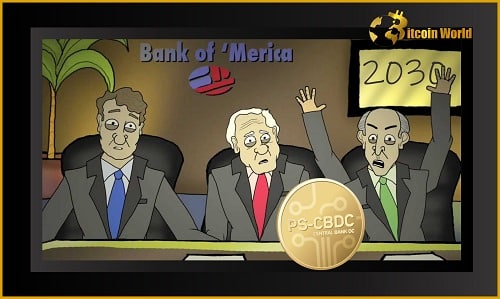Is the digital dollar coming to the United States sooner than we think? While the US government seems to be taking its time exploring the idea of a Central Bank Digital Currency (CBDC), a major financial institution, Bank of America, is making waves with a bold prediction: a US CBDC is not just possible, but “inevitable.” Let’s dive into what this means for Americans, the future of our money, and the role of digital currencies in the global financial landscape.
Why Bank of America Thinks CBDCs Are Inevitable
According to analysts at Bank of America, the shift towards CBDCs is a natural progression in our increasingly digital world. They argue that just as we’ve moved from physical cash to electronic payments, the next step is a fully digital form of government-backed currency. Think of it as a digital upgrade to the dollar bill in your wallet.
Here’s why this prediction is significant:
- Following a Global Trend: Many countries are already exploring or even launching their own CBDCs. While the US might seem like it’s lagging behind, Bank of America believes it’s a matter of ‘when,’ not ‘if,’ for the world’s largest economy to join this digital revolution.
- Evolution of Electronic Money: We already use digital forms of money daily through online banking, credit cards, and payment apps. CBDCs are seen as a more formalized and potentially more efficient evolution of these existing electronic currencies.
- Stablecoins Will Thrive Too: Interestingly, Bank of America analysts also believe that stablecoins, cryptocurrencies pegged to traditional currencies like the dollar, will continue to play a vital role alongside CBDCs. This suggests a future where different types of digital currencies coexist.
The US and the CBDC Race: Slow and Steady Wins the Race?
While nations like China are actively piloting their digital yuan, the US has adopted a more cautious approach. Federal Reserve Chair Jerome Powell has emphasized the need to “get it right” rather than being the first to launch a CBDC. This cautiousness stems from the unique position of the US dollar as the world’s reserve currency and the complexities of the American financial system.
Why the US is Taking its Time:
- Economic Impact: Introducing a CBDC could have profound implications for the US economy, affecting everything from monetary policy to the role of commercial banks. The Fed wants to thoroughly understand these impacts before making any major moves.
- Privacy Concerns: Unlike decentralized cryptocurrencies, CBDCs would be issued and controlled by the central bank. This raises significant questions about privacy and government surveillance. How can a US CBDC be designed to protect citizens’ financial privacy?
- Technological Infrastructure: Building the infrastructure for a US CBDC is a massive undertaking. It requires robust, secure, and scalable technology to handle the vast volume of transactions in the US economy.
What Did the Fed’s Recent Paper Reveal About a US CBDC?
The Federal Reserve recently released a discussion paper exploring the potential benefits and risks of a US CBDC. This paper is a crucial step in the US CBDC journey, signaling a more serious consideration of the idea.
Key Takeaways from the Fed’s CBDC Paper:
| Potential Benefits | Potential Challenges |
|---|---|
|
|
When Can We Expect a US CBDC? Bank of America’s Timeline
Bank of America analysts, Alkesh Shah and Andrew Moss, estimate that a US CBDC could become a reality between 2025 and 2030. While this is just a prediction, it suggests that the conversation around a digital dollar is moving from theoretical discussions to a more concrete timeline.
Factors that Could Influence the Timeline:
- Regulatory Clarity: Clear regulations and legal frameworks will be essential for the development and adoption of a US CBDC.
- Technological Advancements: Continued advancements in blockchain and distributed ledger technology could pave the way for a more efficient and secure CBDC infrastructure.
- Public and Political Will: Public acceptance and political support will be crucial for the successful implementation of a US CBDC. This includes addressing concerns about privacy and ensuring broad access.
Are Americans Ready for a Digital Dollar?
The idea of a digital dollar raises many questions for everyday Americans. Will it make payments easier? Will it impact our privacy? Will it change how we interact with banks? These are all valid concerns that need to be addressed as the US moves closer to potentially launching a CBDC.
Key Questions for Americans to Consider:
- Privacy vs. Efficiency: How do we balance the potential benefits of a CBDC with the need to protect individual financial privacy?
- Accessibility and Inclusion: Will a CBDC be accessible to everyone, including those without smartphones or reliable internet access?
- Security and Trust: Can a US CBDC be made secure and trustworthy enough to gain widespread public adoption?
Conclusion: The Inevitable Digital Future of the Dollar
Bank of America’s prediction of an “inevitable” US CBDC by 2030 underscores the growing momentum behind digital currencies globally. While the US is taking a measured approach, the potential benefits of faster payments, reduced costs, and financial innovation are hard to ignore. As the conversation around a digital dollar intensifies, it’s crucial for Americans to stay informed, engage in the discussion, and help shape the future of money in the digital age. The journey towards a US CBDC is likely to be a complex one, but as technology continues to reshape our world, the digital evolution of the dollar seems increasingly likely.
Related Posts – Ex-SEC Chair, Jay Clayton Believes Cryptocurrency Industry Is For Long Haul
A Digital European Project In Works With Italian Payments Provider Nexi
Disclaimer: The information provided is not trading advice, Bitcoinworld.co.in holds no liability for any investments made based on the information provided on this page. We strongly recommend independent research and/or consultation with a qualified professional before making any investment decisions.


